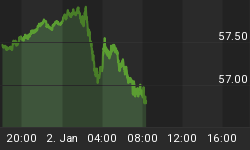If there's such a thing as a "Volumist" for stock market technician, who specializes in the study and analysis of trading volume, then I'd be honored to be a "Volumist". Trading volume is sometimes considered the most important demand and supply technical trend indicator by some well established academicians and professional traders. In that vane, unusual occurrence of volume formation should also be considered an important indicator for potential shift in market trend.
Nasdaq's trading volume had never exceeded 60% of the combined daily volume of all 3 major exchanges until this year, 2007. And, in only 18 of these trading days, since I started tracking this volume data, Nasdaq's volume had surpassed 60%. All 18 occurred this year. 15 of these heavy Nasdaq volume days took place right now in October, with Friday's 63.93% as the new record high. The other 3 days occurred on 2/20/2007, 4/25/2007, and 9/26/2007 (see Chart 1 below).

Chart 1

Chart 2
Nasdaq's volume reached 60.58%, for the first time, on 2/20/2007. It then dropped below 60% on the very next day and continued to decline until the volume reached a tad below 50% on 3/16/2007. Chart 2 above indicates 2/20/2007 corresponds with the approximate Nasdaq market top, and 3/16/2007 corresponds with the approximate bottom. It took 19 days to complete that process.
On 4/25/2007, Nasdaq's trading volume surged past 60% again. This time, however, it took 80 days till 8/17/2007 to finally descend to 50%. As we can see on Chart 2 that 4/25/2007 was no where near the top of the market. But, 8/17/2007 was only 1 day past the market bottom. It's just as close to the market bottom as 3/16/2007. Therefore, it should be safe to assume certain statistical probability of a market bottom when the Nasdaq trading volume retreats from 60% to 50%. Incidentally, this might've been the reason why the correction in July and August was so severe. Nasdaq's choppy advance from April to July was not supported by volume. The flat range of Nasdaq's relative volume from April to August (revisit Chart 1 above) was a technical divergence against the price movement.
At any rate, although the "60% rule" may not have timed the market top accurately, it does indicate the probability of the beginning of a top building process. Were that the case, then this market top building process might've already begun on 9/26/2007, when the Nasdaq trading volume reached 60% again.
Friday's record high of 63.93% provided us with a benchmark, which was primarily attributed to Microsoft's 333% and Yahoo's 133% gush of trading volume. Without their respective contribution, Nasdaq's trading volume would've been at a 4-session low on Friday. Since Microsoft's exceptional one-day surge of 222 million shares was a feast that's unlikely to be repeated, Nasdaq's volume should be just as unlikely to exceed this benchmark.
The market's currently rebounding from the short-term oversold condition that I mentioned last Sunday. It's also been held together by another possible 0.50% rate cut by the Fed this week. But the longer-term picture continues to look bleak. Unless a new paradigm of volume distribution had just been born, at some point, Nasdaq's trading volume will have to start retreating, like it always has. And, the market that's been driven by the tech sector rally will have to start retreating as well.
It's been 23 days, since 9/26/2007, the commencement of this market top building process, and counting...
















